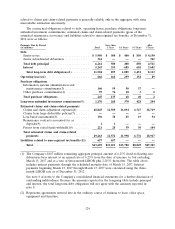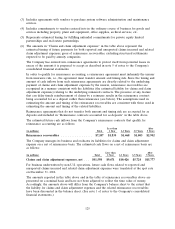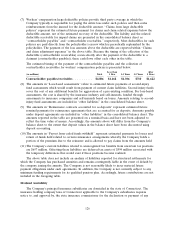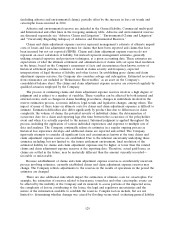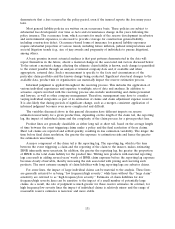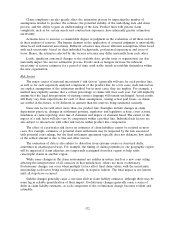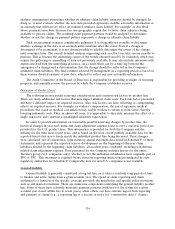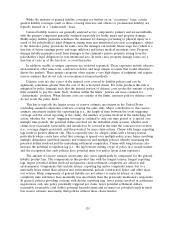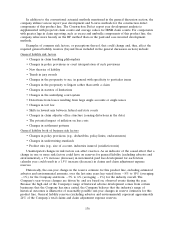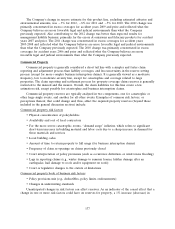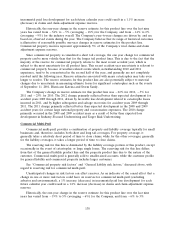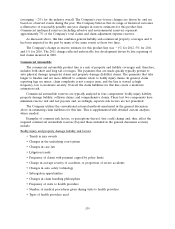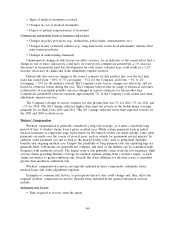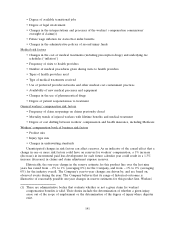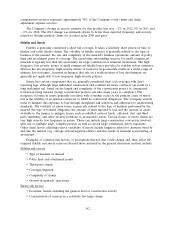Travelers 2012 Annual Report Download - page 146
Download and view the complete annual report
Please find page 146 of the 2012 Travelers annual report below. You can navigate through the pages in the report by either clicking on the pages listed below, or by using the keyword search tool below to find specific information within the annual report.
analyses, management determines whether its ultimate claim liability estimates should be changed. In
doing so, it must evaluate whether the new data provided represents credible actionable information or
an anomaly that will have no effect on estimated ultimate claim liability. For example, as described
above, payments may have decreased in one geographic region due to fewer claim adjusters being
available to process claims. The resulting claim payment patterns would be analyzed to determine
whether or not the change in payment pattern represents a change in ultimate claim liability.
Such an assessment requires considerable judgment. It is frequently not possible to determine
whether a change in the data is an anomaly until sometime after the event. Even if a change is
determined to be permanent, it is not always possible to reliably determine the extent of the change
until sometime later. The overall detailed analyses supporting such an effort can take several months to
perform. This is because the underlying causes of the trends observed need to be evaluated, which may
require the gathering or assembling of data not previously available. It may also include interviews with
experts involved with the underlying processes. As a result, there can be a time lag between the
emergence of a change and a determination that the change should be reflected in the Company’s
estimated claim liabilities. The final estimate selected by management in a reporting period is based on
these various detailed analyses of past data, adjusted to reflect any new actionable information.
The Audit Committee of the Board of Directors is responsible for providing oversight of reserving
propriety, and annually reviews the process by which the Company establishes reserves.
Discussion of Product Lines
The following section details reserving considerations and common risk factors by product line.
There are many additional risk factors that may impact ultimate claim costs. Each risk factor presented
will have a different impact on required reserves. Also, risk factors can have offsetting or compounding
effects on required reserves. For example, in workers’ compensation, the use of expensive medical
procedures that result in medical cost inflation may enable workers to return to work faster, thereby
lowering indemnity costs. Thus, in almost all cases, it is impossible to discretely measure the effect of a
single risk factor and construct a meaningful sensitivity expectation.
In order to provide information on reasonably possible reserving changes by product line, the
historical changes in year-end claims and claim adjustment expense reserves over a one-year period are
provided for the U.S. product lines. This information is provided for both the Company and the
industry for the nine most recent years, and is based on the most recent publicly available data for the
reported line(s) that most closely match the individual product line being discussed. These changes
were calculated, net of reinsurance, from statutory annual statement data found in Schedule P of those
statements, and represent the reported reserve development on the beginning-of-the-year claim
liabilities divided by the beginning claim liabilities, all accident years combined, excluding non-defense
related claim adjustment expense. Data presented for the Company includes history for the entire
Travelers group (U.S. companies only), whether or not the individual subsidiaries were originally part of
SPC or TPC. This treatment is required by the statutory reporting instructions promulgated by state
regulatory authorities for Schedule P. Comparable data for non-U.S. companies is not available.
General Liability
General liability is generally considered a long tail line, as it takes a relatively long period of time
to finalize and settle claims from a given accident year. The speed of claim reporting and claim
settlement is a function of the specific coverage provided, the jurisdiction and specific policy provisions
such as self-insured retentions. There are numerous components underlying the general liability product
line. Some of these have relatively moderate payment patterns (with most of the claims for a given
accident year closed within five to seven years), while others can have extreme lags in both reporting
and payment of claims (e.g., a reporting lag of a decade or more for ‘‘construction defect’’ claims).
134


